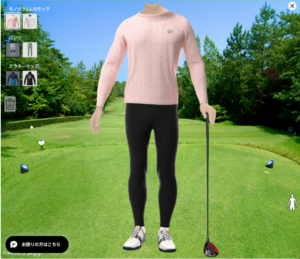Shopping at Otero Menswear is an unorthodox experience.
Before viewing any clothing, customers first answer three questions about their body size and shape to create an avatar.
“The first thing you do is pick these data points that create your virtual avatar, and then that virtual avatar travels with you through the entire site,” founder and CEO Steve Villanueva said. “So whether you’re picking a polo or a T-shirt, this size, or this color, whatever your avatar wears, you can see it on.”
Perfitly’s AI avatar fitting room
Otero uses Perfitly, an AI fitting tool that allows consumers to visualize clothing on their bodies. Perfitly is based on the idea of recreating the fitting rooms in brick-and-mortar stores, CEO and co-founder Dave Sharma told Digital Commerce 360. It works differently from many other fitting tools on the market that recreate a 3D garment in 2D, Sharma said.
Some fitting tools “utterly ignored what the garments are made of. A jersey dress versus a silk dress with exactly the same dimensions is going to look and sit very differently,” he said. “There’s no interaction with the human shape and understanding of what the thing is actually going to look like when it gets to you.”
Perfitly creates a 3D avatar of a consumer from user-submitted full-body images with about 98% accuracy, Sharma said. Consumers can then digitally try on different garments and sizes, with the ability to rotate and zoom in on the avatar. The AI makes size recommendations and displays the clothing using 3D digital assets the retailer provides that take into account properties of the fabric including weight, stretch, and density. The tool can also create avatars based on data inputs from customers, as in the case of Otero.

TaylorMade-Japan’s Perfitly Avatar
Sharma’s goal with Perfitly is to reduce returns and grow conversions by mimicking the in-store shopping experience. He says Perfitly increased conversions 80% on average, from 4% to 7.2%, and reduced returns 67%, from 28% to 10%.
Otero uses Perfitly to sell menswear
Otero, which sells clothes for men with heights between 5’4” and 5’10”, made Perfitly the centerpiece of its ecommerce business. When customers enter the website, they must input data about themselves to create an avatar before viewing products. Making the avatar the entry point of the site was key to fixing the “up-front complexity” in Otero’s products, Villanueva said. Once customers saw how the retailer’s shirts were designed proportionally to fit their body type, they were much more likely to buy, he says. Otero’s conversion rate is 3%, he shared.
Otero’s return rate is well below the industry standard at 3%. Villanueva attributes what he calls a “ridiculously low” return rate to Perfitly’s accuracy. There have been some bumps in return rates as Otero and Perfitly tweaked the questions and avatars, he said, but it never exceeded 9% and always settles back between 2 and 3%. That’s far below the industry standard, Villanueva said.
Returns can be an expensive problem
Returns can be costly for retailers. Companies pay an average of $26.50 to process $100 in returned merchandise, The Wall Street Journal reported in May. In 2022, about 16.5% of retail purchases were returned, totaling about $816 billion, according to the National Retail Foundation. Average return rates are higher for apparel, at 24.4% according to a study from Coresight Research. Size and fit are the largest reasons for returns, driving 53%, according to the study.
Those returns can lead to further lost profits, if garments are out of season when they’re returned, Sharma said.
Do you rank in our database?
Submit your data with this quick survey and we’ll see where you fit in our next ranking update.
Sign up
Stay on top of the latest developments in the ecommerce industry. Sign up for a complimentary subscription to Digital Commerce 360 Retail News.
Favorite